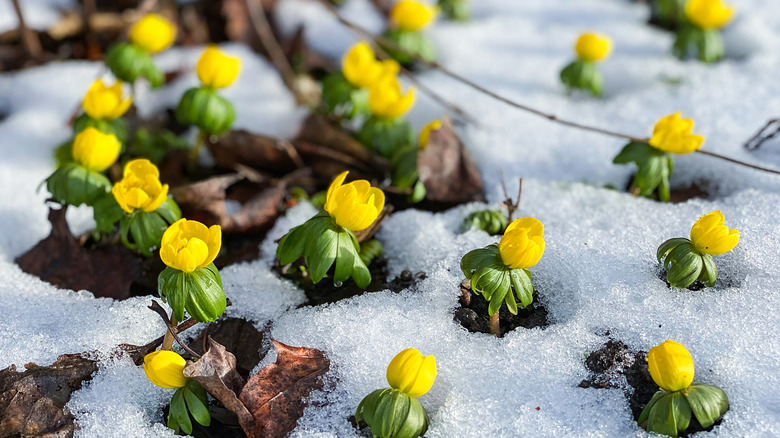The Perennial To Plant In Fall For Stunning Blooms In Late Winter
We may receive a commission on purchases made from links.
By late winter, you've probably had enough of the gloomy weather, chilly temperatures, and boring dormant garden. Luckily, there's a flower you can plant in the fall that will bloom all the way through late winter and into early spring — even before your crocuses appear. Winter aconite (Eranthis hyemalis) is a perennial tuber with cheerful yellow flowers that you should grow for more winter cheer. Planting winter aconite in the fall is ideal, especially in the Southern states. This gives them plenty of time to establish their bulbous root system before spring. Fall's cool temperatures allow the tubers to grow without warm weather stress.
Winter aconites are hardy in Zones 4 to 7. They're low-maintenance and, with their tiny but bright blooms, surprisingly high-reward. They'll quickly become a vital component of your beautiful garden, which looks stunning in winter weather. The rainy weather in fall, when you should plant them, means you won't need to water them that often. Light fertilization and mulching are enough to keep them happy through the winter. After winter aconites go dormant in late spring, their care needs decrease. Minimal yet consistent care will keep them strong and healthy for the next season. They're a good early season source of food for butterflies and other pollinators. Oh, and did we mention that they're also resistant to most pests and diseases?
How to grow and care for winter aconite
Winter aconite tubers are available for purchase any time of year — for example, you can get a 30-pack of Easy to Grow Eranthis Winter Aconite Plant Bulbs for a bit under $22 online. You can also visit your local plant nursery in late summer or fall. Choosing the right location is important if you want your winter aconites to flourish. An appropriate site ensures the tubers produce lots of stunning blooms to brighten your winter garden. Select a spot with rich, slightly acidic, and well-draining soil. Winter aconite tubers like to stay moist, but don't do well in boggy beds. It's also beneficial to plant them under deciduous trees. When they bloom in late winter to early spring, they enjoy the ample sunlight the bare branches let through. As your winter aconite plants go dormant in late spring and the trees above sprout new leaves, the perennial tubers benefit from the dappled sunlight and afternoon shade.
Plant the tubers (flat side down) 2 to 3 inches deep and 3 to 4 inches apart. Cluster them together so they look fuller when they flower. Layer mulch lightly over the planting bed to lock in the moisture these plants love and stabilize soil temperatures. Pine needles or pine bark are great mulch options if you also need to make your soil more acidic for a healthy garden, though the efficacy is debated. Water the tubers thoroughly right after planting. To help the tubers establish roots well, keep them consistently moist but, again, not drenched. Excess water can quickly lead to root rot. Apply a fertilizer that's lower in nitrogen right after planting to support root growth and encourage flowers over foliage.

